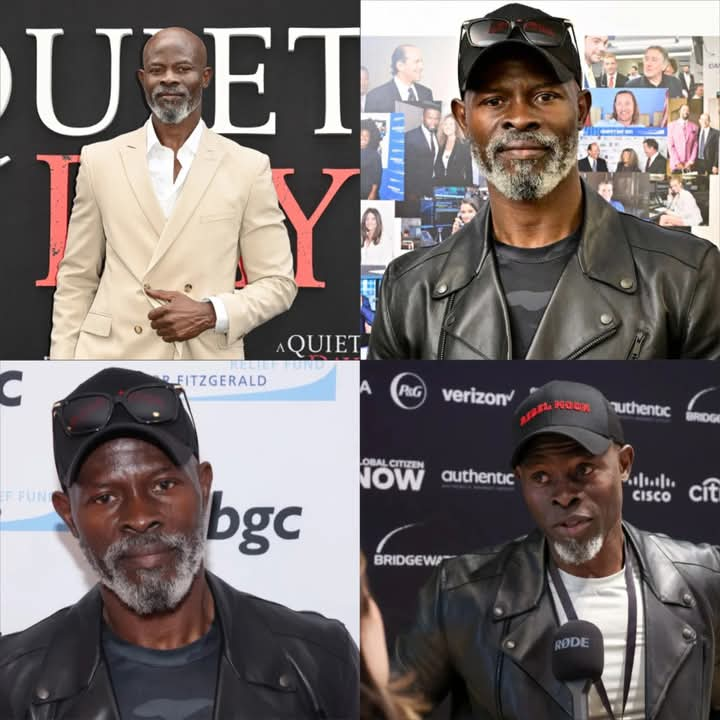NFL
Djimon Hounsou shared that he was treated “worse than a dog” on movie sets. What happened?

Djimon Hounsou shared that he was treated “worse than a dog” on movie sets. What happened? – See details in comments👇👇👇
Djimon Hounsou shared that he was treated “worse than a dog” on movie sets.
Flatliners is in dire need of resuscitation. As of Sunday evening, the film is sporting a three percent rating on Rotten Tomatoes, based on 38 reviews. For much of the weekend, it was at zero percent before the review aggregator added this 3/5 review from the Daily Telegraph.
Flatliners, a remake of Joel Schumacher’s 1990 film of the same name, is directed by Niels Arden Oplev and stars Ellen Page, Diego Luna, Nina Dobrev, James Norton and Kiersey Clemons as medical students who stop their hearts in order to get a glimpse of the afterlife. Unfortunately for them, aspects of the afterlife starts following them back into real life to haunt them.
Schumacher’s Flatliners, which starred Julia Roberts and Kiefer Sutherland, was hardly a hit with critics, but holds a much higher score on Rotten Tomatoes: 49 percent. It also went on to be a financial success. The remake, which has a budget of $19 million, is expected to make somewhere between $5 million and $8 million this weekend.
Here’s a look at what the critics made of the movie.
The Hollywood Reporter’s John DeFore wasn’t all negative on the film, but begins his review this way: “How many Do Not Resuscitate jokes will be made about Flatliners, Hollywood’s latest attempt to bring a long-forgotten hit back from the dead for an audience raised on reheated cultural leftovers? A few, no doubt.”
He notes that the remake is an improvement on the original when it comes to diversity of the cast (there are now more women than men), but writes that the film’s supernatural gimmick gets dull fast: “Forcing each character to endure pretty much the same kind of haunted-by-guilt episode individually burns up plenty of screen time without compounding the pic’s scares. It also allows the viewer’s increasingly idle mind to wonder why, nearly three decades later, the plot’s semi-intriguing premise couldn’t be put to less daffy use. Now as then, dying is just another path to the kind of amends-making every twelve-stepper has to do. If you don’t get to see God or at least one hell of a light show, what’s the point?”
IndieWire‘s David Ehrlich notes that the film doesn’t explore the fact that the world is different than when Schumacher made his film: “If only its irony were the most painful thing about Flatliners, an artless and agonizingly boring remake of a semi-forgotten movie about the dangers of bringing things back from the dead,” he writes. “Lazily recycling the ’90s schlocky Joel Schumacher thriller of the same name (once a staple of video store shelves everywhere), this lifeless new version hits all the same beats as the original, but does so without a speck of the baroque style that made it such a fun thing to rent on a Friday night.”
The New York Times’ Glenn Kenny writes that Flatliners didn’t have the uphill battle that some remakes face, in that the original wasn’t all that beloved at the time to begin with (“The potential for accusations of sacrilege is minimal”). And Kenny highlights one area the film that is actually an improvement: “Mr. Schumacher’s movie is more a failed tone poem than a horror picture, and to its credit, this new version, with a trickier script by Ben Ripley and hyper-competent direction from the Swedish filmmaker Niels Arden Oplev improves on it — by making it behave like a horror movie every now and then.”
The film did not screen for critics, usually a sign the studio knows it’s bad.
“I imagine Columbia understood that it had something arguably worse than a dog on its hands. This Flatliners is in fact a new definition of ‘meh,’ ” Kenny writes.
Time Out New York’s Michael Gingold wrote that there was potential for a film about people being haunted by deeds of their past, particularly in the age of the internet when it’s harder for sins to disappear. But, he concludes, Flatliners is “hackneyed horror devices uneasily mixed with softball dramatics of atonement, to increasingly plodding effect.”
Similarly, A.V. Club critic Mike D’Angelo asked if the film’s creators had figured out something new to do with the 1990s concept. The answer? “Nope. Flatliners 2017 is the same dumb movie as Flatliners 1990, minus most of the surface charisma.”
The seemingly only innovation from the film is that the medical students gain certain abilities (such as a photographic memory) after flatlining. Unfortunately, “None of the actors succeeds in making any of this nonsense credible, or even in establishing much of a personality,” he writes. “The movie’s second half traps all of them in generic jump-scare horror sequences, indifferently staged by director Niels Arden Oplev.”
Empire‘s John Nugent calls out the use of Sutherland, who returns from the original film. Sutherland himself has suggested he was playing the same character, something that had dramatic potential.
“Sutherland was sold as the connective tissue between the two films, and his character could have offered true mentorship or advice to students performing identical experimental procedures to his,” Nugent writes. “But his cameo is largely pointless. There is zero reference to the events of the last film. Instead he is left to stomp around irascibly with a walking stick, like a less brilliant Dr. House. He is the most visible ghost of all: the vision from the past, haunting the present, reminding us that this all happened before, and marginally better.”
Los Angeles Times critic Noel Murray does find one silver lining: “The new filmmaking team of writer Ben Ripley and director Niels Arden Oplev makes the original’s members look like peerless masters of horror.”












